Mastering ChatGPT in content marketing can transform how you create, improve, and scale your digital content. ChatGPT helps marketers save time. It generates ideas and engages audiences. AI-powered content strategies focus on growth and performance. These strategies are tailored for blog writing, SEO, social media, and email campaigns.
OpenAI’s ChatGPT is a potent AI tool. It has been trained on various data, such as books, articles, and websites. It uses Natural Language Processing (NLP) to understand and respond to human language. This approach is conversational and makes it ideal for content creation. It is also perfect for digital marketing, customer support, and more.
One of ChatGPT’s standout features is its ability to learn from context through unsupervised learning. This allows it to respond contextually to prompts without relying on pre-written templates or fixed rules.
For marketers, this means you can generate relevant content simply by entering prompts in natural language. The clearer and more detailed your prompt, the better the output you’ll receive. Whether you’re creating blog posts, social media content, emails, or ad copy, ChatGPT can adapt and deliver in seconds.
Whether you’re writing blog posts or creating social media copy, you must master ChatGPT in content marketing. This skill gives you a competitive edge.
Generating High-Quality Articles with ChatGPT
If you want to stay ahead in the digital space, you must master ChatGPT in content marketing. This mastery leads to faster and smarter content creation.
When it comes to blog writing or long-form content creation, ChatGPT offers tremendous value. It can help you:
- Generate fresh article ideas
- Build SEO-optimized outlines
- Draft introductions and full-length articles
- Rewrite or improve existing content
- Maintain tone and consistency throughout
Step-by-Step Workflow:
Step 1: Brainstorm Article Ideas
Start by prompting ChatGPT with something like: “Give me 10 blog post ideas on [topic]”
For example:
Give me 10 blog post ideas list on “dog training.”
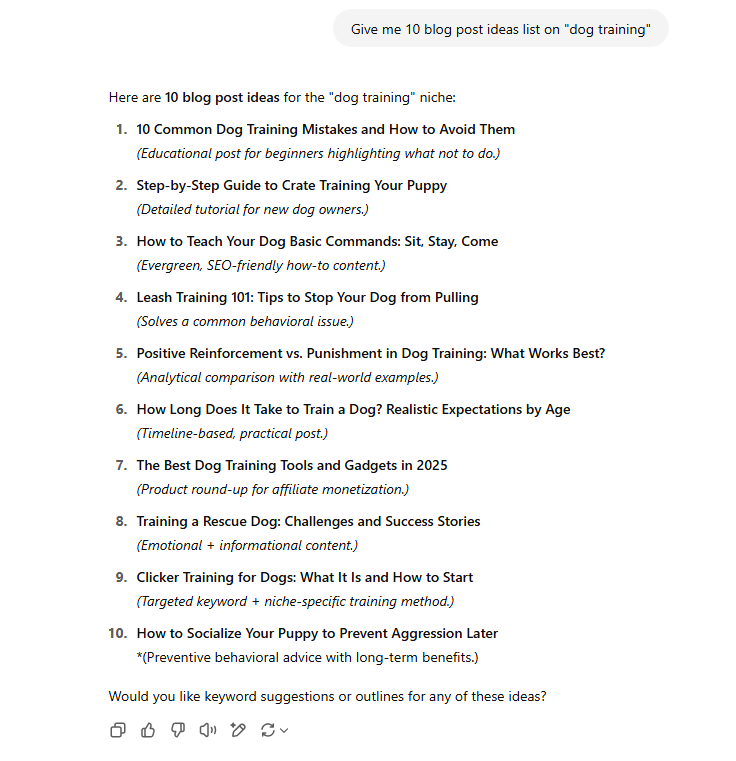
Step 2: Generate an Outline
Next, select an idea and request an outline:
“Create an outline for idea number 3.”
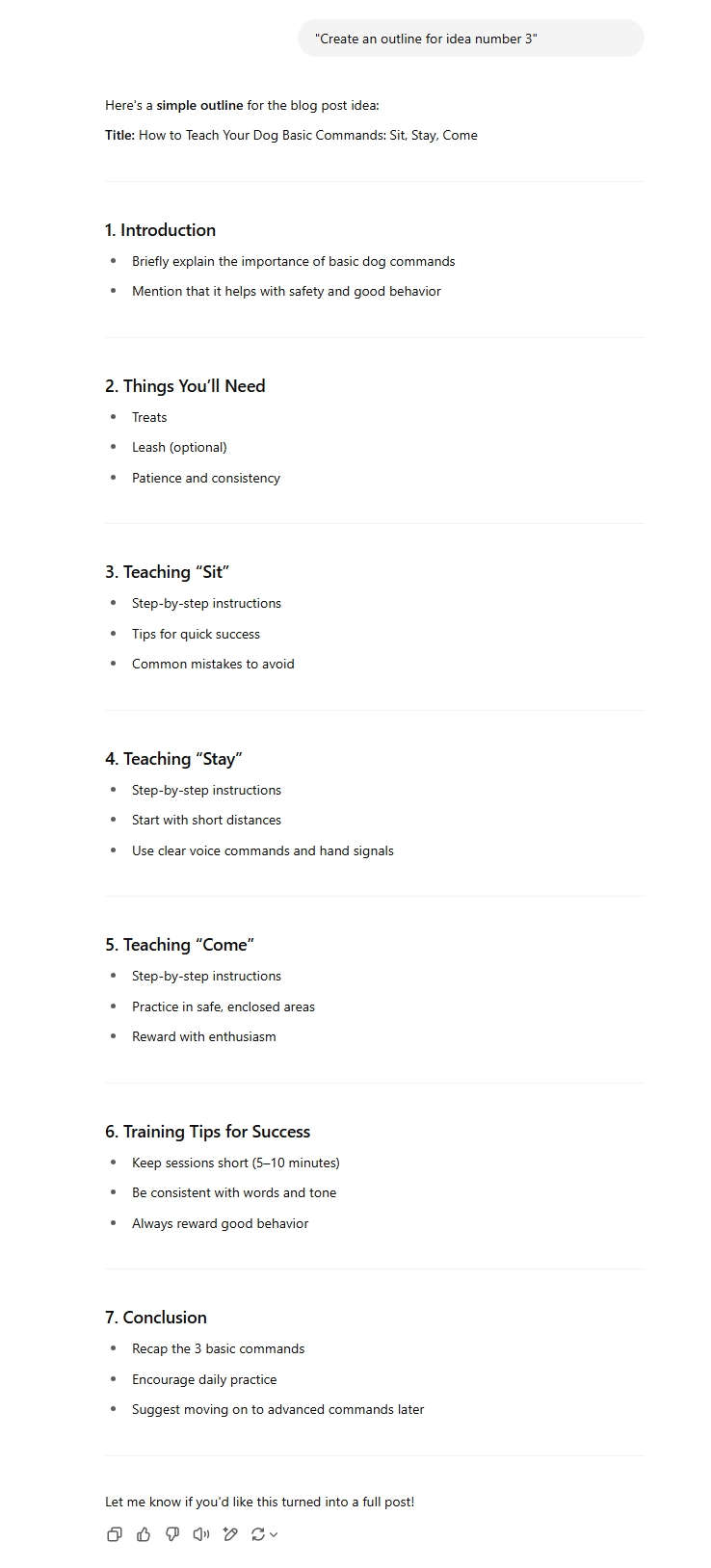
Step 3: Write the Introduction
With the structure in place, prompt:
“Write a 300-word introduction for this article.”
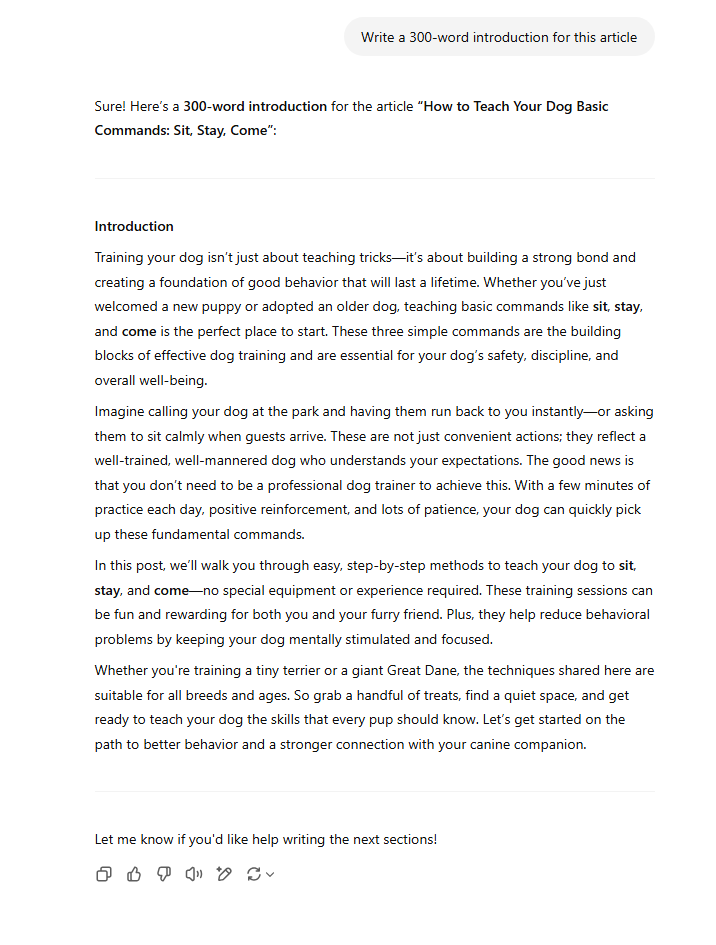
Step 4: Build the Body
Break down the outline into sections and ask ChatGPT to expand on each:
“Write 500 words about section 2.” (or) Expand section 2.
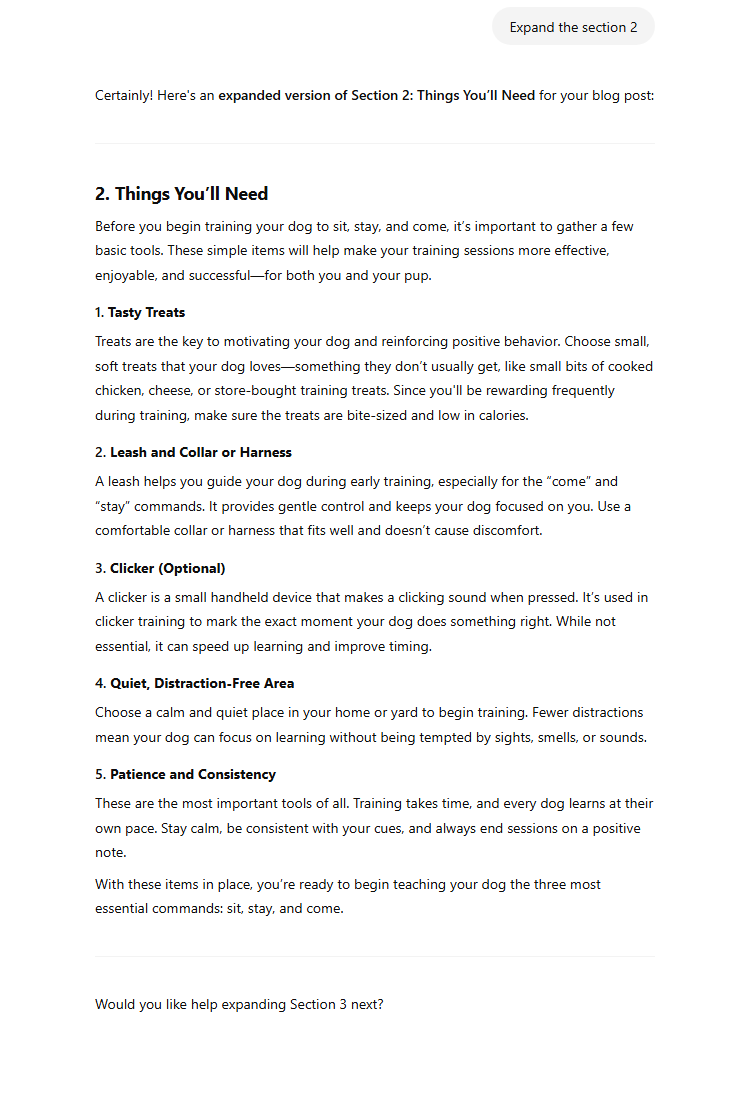
Continue the same prompt by changing the section number like this:
“Write 500 words about section 3.” (or) Expand section 3.
“Write 500 words about section 4.” (or) Expand section 4.
“Write 500 words about “conclusion” section.” (or) Expand “Conclusion” Section.
Step 5: Writing the Main Body of the Article
While ChatGPT provides solid drafts, copy and paste them into Google Docs or Microsoft Word. Always review, fact-check, and personalize the content before publishing.
Once you’ve outlined your article, the next step is to flesh out each section. First, take a moment to decide how long you want the entire blog post to be. Then, break that number down based on how many headings or sections you have. This helps you figure out roughly how many words you’ll need for each part.
As you work through the sections, ask ChatGPT to generate content for each one individually. Once it’s done, review the text—feel free to use it as-is or tweak it to match your voice and brand. And don’t forget to double-check the facts to ensure everything is accurate and up to date.
Generating Engaging Social Media Posts with ChatGPT
Creating captivating content for platforms like LinkedIn, Twitter, and Facebook requires brevity and audience awareness. ChatGPT excels here too, producing engaging posts that spark interest and interaction.
Many successful brands now master ChatGPT in content marketing to streamline their workflows and maintain consistent publishing schedules.
Tips for Using ChatGPT for Social Media:
- Know Your Audience: Provide clear details about your ideal reader or follower.
- Be Specific: Include character limits, brand tone, and hashtags in your prompt.
- Refine Content with Follow-Ups: Ask for variations or edits to fit different platforms.
Use Cases:
Step 1: Generate Content Ideas with ChatGPT
“Give me 5 social media post ideas for busy freelancers who love coffee.”
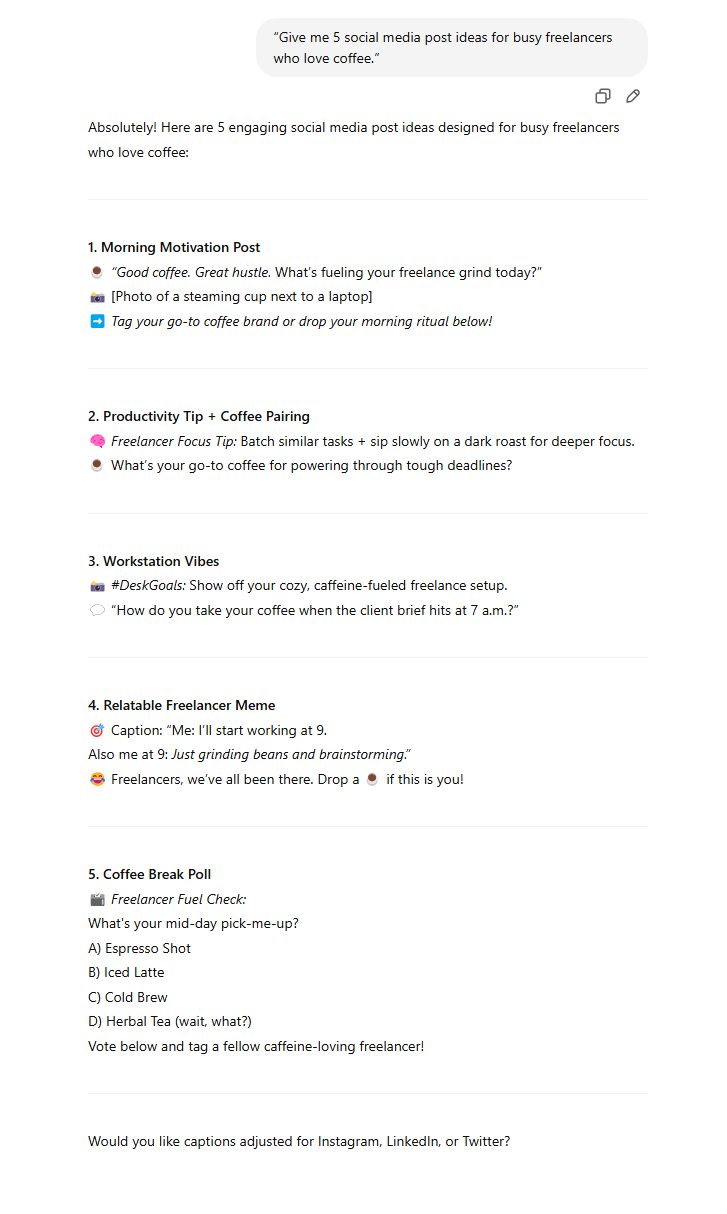
Step 2: Creating Content for Linkedin
“Write a LinkedIn post for our new coffee brand, ‘Hussle Fuel,’ announcing our launch and a BOGO deal.”
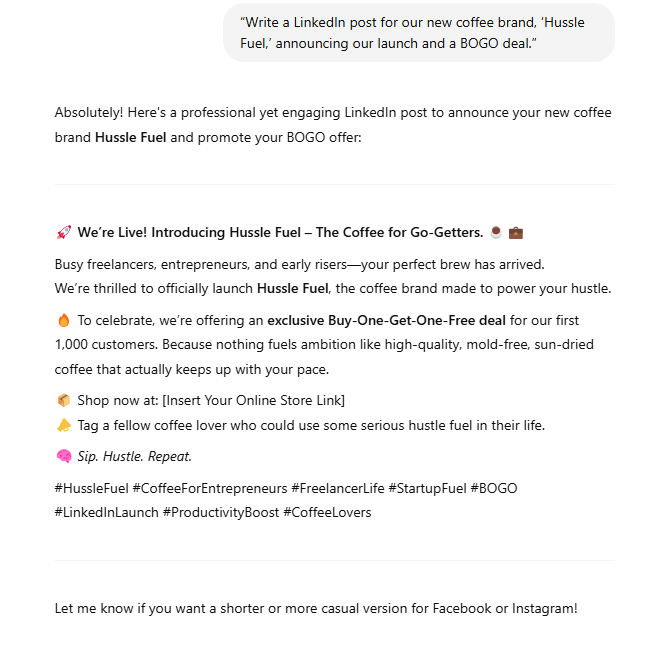
Step 3: Create Content for Facebook
“Repurpose the LinkedIn post for Facebook and include an invite to join our Facebook group.”
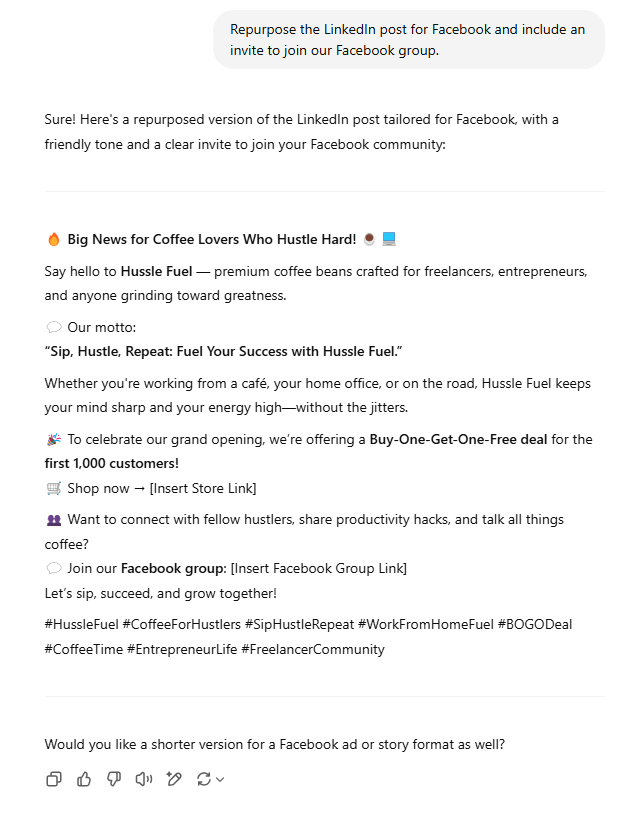
Step 4: Creating X Threads (Formely “Twitter”)
“Create a 5-tweet thread promoting Hussle Fuel’s benefits and our New Year offer.”
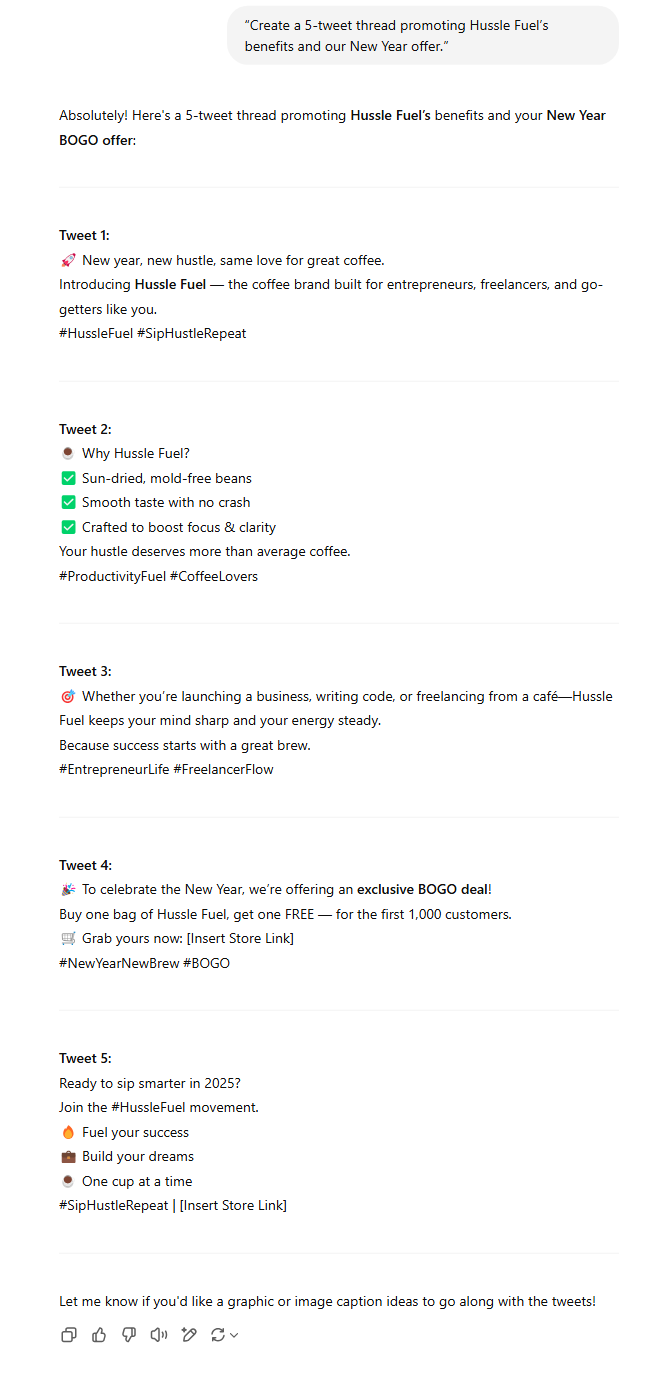
By tailoring your prompts, you can consistently create engaging, platform-specific content that drives interaction.
Writing Professional Emails and Letters: What to Keep in Mind
When using ChatGPT to draft professional emails or letters, it’s essential to understand the basics of good communication.
While the AI can generate helpful content, it’s still your responsibility to review and refine the message before hitting send.
To truly unlock the power of AI-driven strategy, marketers must first master ChatGPT in content marketing for audience-focused results. Here are some key tips to keep your writing polished and professional:
- Start with a Clear Purpose: Make sure your message has a specific goal. Reflect that purpose right away, either in the subject line or the opening sentence. This way, the reader knows exactly what it’s about and what action, if any, they need to take.
- Maintain a Professional Tone: Use proper grammar and spelling. Avoid using slang, overly casual language, or anything that might come off as inappropriate or unprofessional.
- Get to the Point: Respect the reader’s time by keeping your message brief and focused. Avoid rambling or including unnecessary details.
- Be Polite and Respectful: Always address the recipient by name when possible. Keep your tone courteous. Do this even if you’re delivering tough feedback or making a request.
- Double-Check Before Sending: Read through your message carefully to catch any typos, unclear phrasing, or factual errors. A quick proofread goes a long way in making a good impression.
Popular Use Cases:
Step 1: Job Application Letter
“Write a letter applying for a content creation role at SEMRush. Mention my 5 years of experience, Adobe Premiere proficiency, and a degree in marketing.”
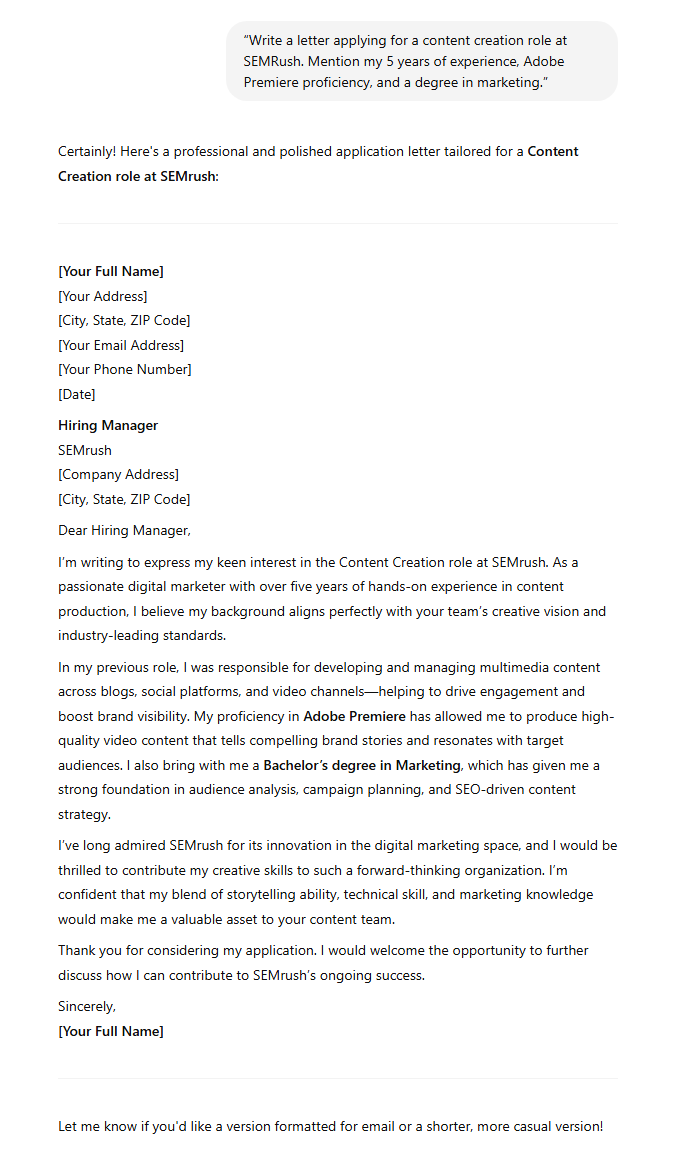
Step 2: Contract Drafting
“Write a 6-month contract for a freelance graphic designer we’re about to hire”
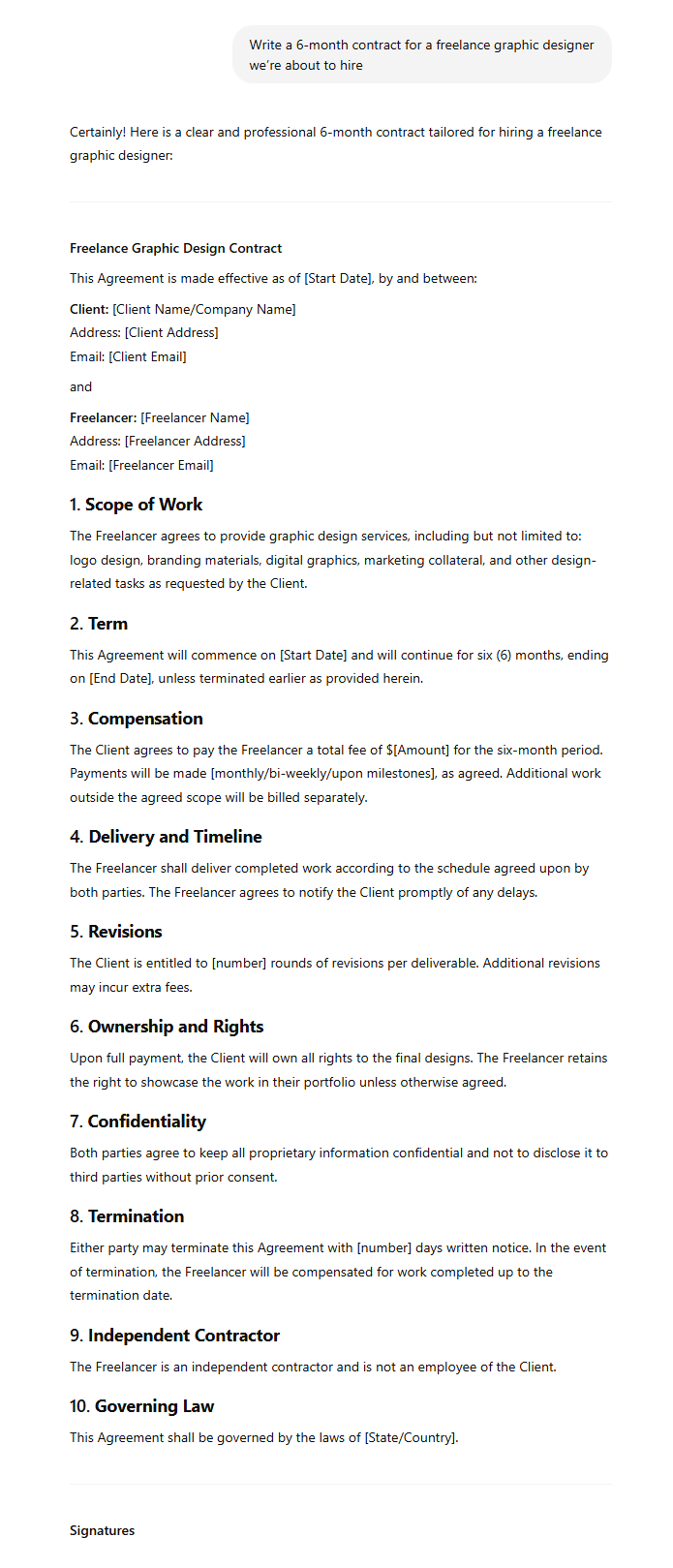
Step 3: Cold Sales Email:
“Write an email offering local SEO services to a pet grooming salon called Bubbles. Emphasize our 20 years of experience.”
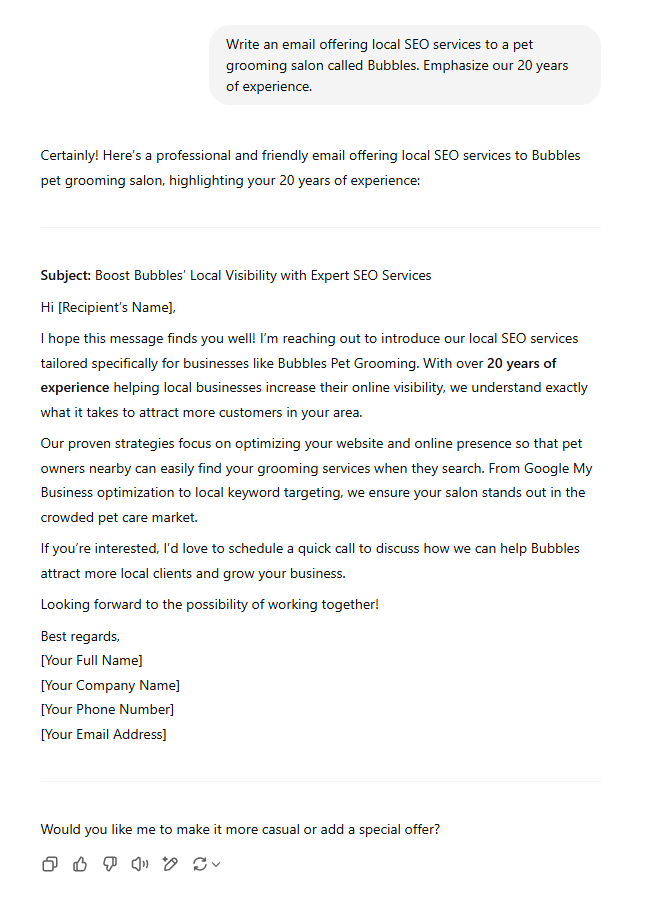
Step 4: Influencer Outreach
“Write a professional email to Thomas D’Angelo inviting him to our podcast and introducing our SEO agency brand.”
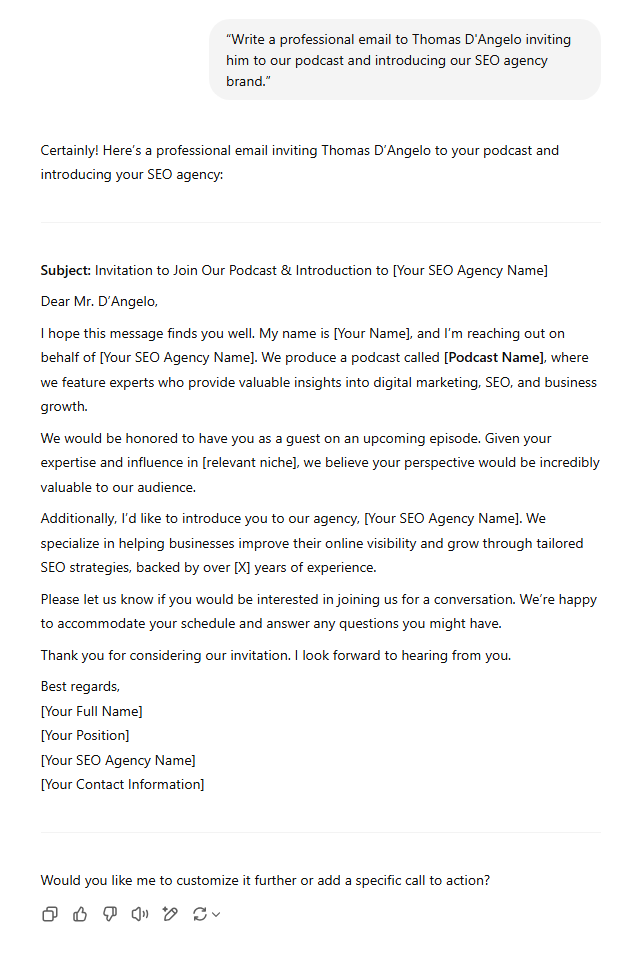
ChatGPT can save time and improve the clarity of your messaging while maintaining professionalism.
Advanced ChatGPT Prompt Techniques
To fully unlock ChatGPT’s potential, you need to go beyond basic prompts. Here are several techniques that can elevate your content quality:
1. Specify Audience Demographics
If you want your content to really resonate, you need to understand who you’re speaking to. That’s why demographics play such a big role in content creation.
When you’re using ChatGPT to generate content, giving it some background about your target audience can make a big difference. The more context you provide—like who the message is for—the better the results.
Factors such as age, gender, and education level can influence how a message should be phrased. Income, relationship status, and job type are also important.
Even where someone lives plays a role. These details help shape the tone and language. They shape the overall approach so the content feels relevant and personal to the people you’re trying to reach.
2. Adjusting Reading Level and Tone Makes a Big Difference
The way your content is written—both in tone and reading level—can completely change how it’s received. When you tailor these elements to fit your audience, your message becomes more relatable and easier to understand.
For example, imagine you’re writing an article about the benefits of working from home. If you’re targeting professionals, the tone might be polished and informative.
But if you’re writing for a younger audience or beginners, a simpler, more casual style might be more effective. Changing the tone and complexity can have a big impact on how well your message connects with different readers.
“Write an article about the benefits of working from home.”

3. Set Dos and Don’ts
When giving instructions to ChatGPT, it’s not just about what you want it to include. It’s also about what you don’t want. These “don’ts,” sometimes called negative prompts, help guide the AI to avoid content that might be off-topic or irrelevant. They also help ensure the content aligns with your audience’s values.
For example, let’s say you’re creating an article for the vegan community on building muscle through diet. You’d want to make sure the content emphasizes whole, plant-based foods.
You’d also need to clearly instruct ChatGPT not to mention meat or dairy. That extra direction ensures the final output stays aligned with your audience’s preferences and lifestyle.
Giving both positive and negative guidance helps the AI deliver content that’s accurate, respectful, and on-brand.
“Write about building muscle on a vegan diet. Do mention whole foods, but don’t mention meat or dairy.”

4. Getting ChatGPT to Write in Character
To make your content resonate with your audience, use ChatGPT creatively. Ask it to write in the voice of someone they already know and trust. This could be an influencer, expert, or public figure who aligns with your target audience’s values or communication style.
By doing this, you can shape the tone, language, and energy of the content. This will better match what your audience expects. It will also align with what they enjoy.
For example, let’s say you’re writing a piece on the benefits of waking up at 4 a.m. to boost productivity—and you know your audience is full of Gary Vee fans. You could ask ChatGPT to write the article in Gary Vee’s voice. The result will sound more direct, passionate, and motivational. It will be just like he talks.
It’s a great way to add personality to your content. It also adds authenticity, especially when you’re trying to connect on a deeper level.
“Write a motivational blog post about waking up at 4 a.m. in the voice of Gary Vee.”
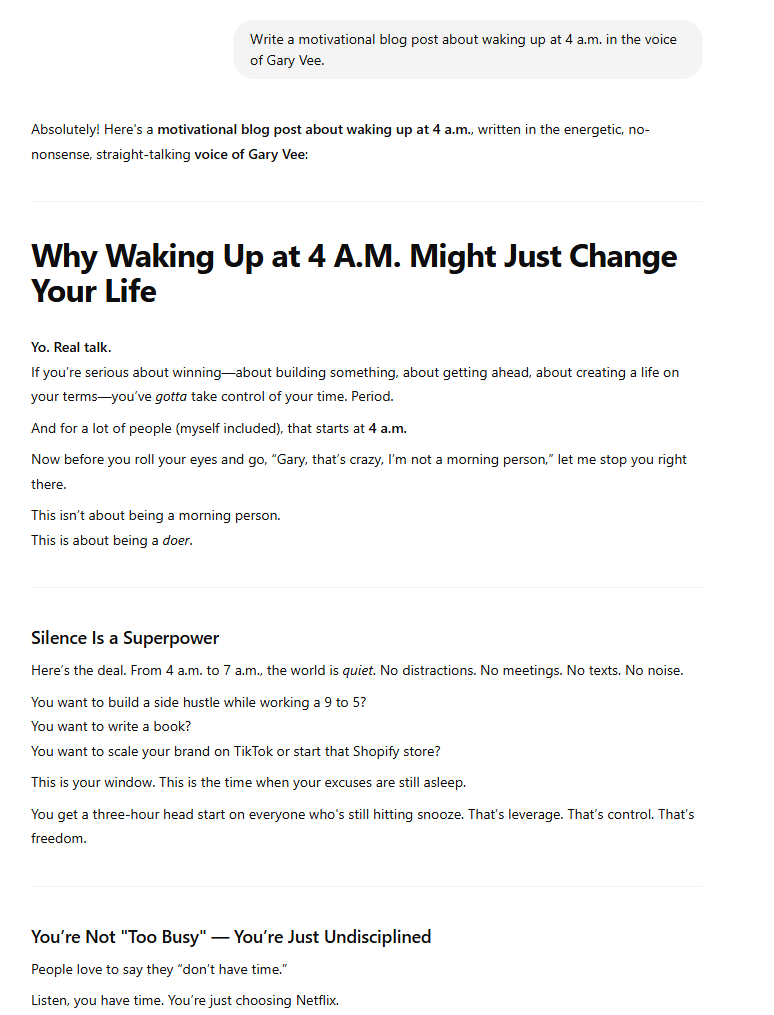
5. Guiding ChatGPT to Shape the Outcome
You have the power to steer the focus toward the specific ideas or angles that matter most to you. This happens when you use ChatGPT to create content.
You can clearly direct what you want emphasized. This helps you generate content that feels more original and meaningful. It is far from the typical, generic pieces you see all over the web.
For example, if you’re writing about the benefits of artificial intelligence (AI), you might find it helpful to consult ChatGPT.
You could ask it to highlight the positive impacts. Additionally, you can explore the potential downsides. AI could widen the gap between those with access to technology and those without. This guidance helps produce a balanced, thought-provoking article that stands out.
“Write about AI’s benefits, but also discuss how it could widen the wealth gap.”

6. Using ChatGPT to Find the Right Keywords and Hashtags
ChatGPT can be a great tool. It helps you come up with relevant keywords and hashtags. These make your content easier to find online.
If you’re writing an article about the benefits of waking up early, you can ask ChatGPT to suggest keywords. ChatGPT can also generate hashtags related to that topic.
“Suggest 5 keywords for an article on waking up early. Then add them to the article.”
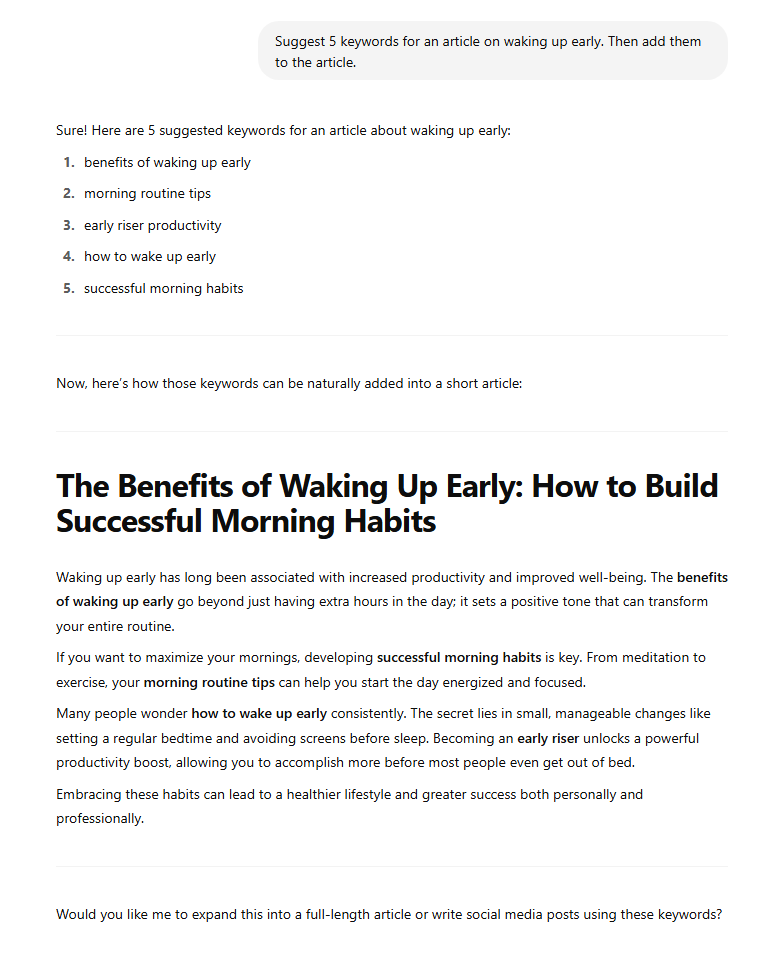
Once you have the list, you can ask ChatGPT to integrate those keywords directly into your article. This method helps achieve a smoother, SEO-friendly flow.
(Follow-up) Give me some relevant hashtags.
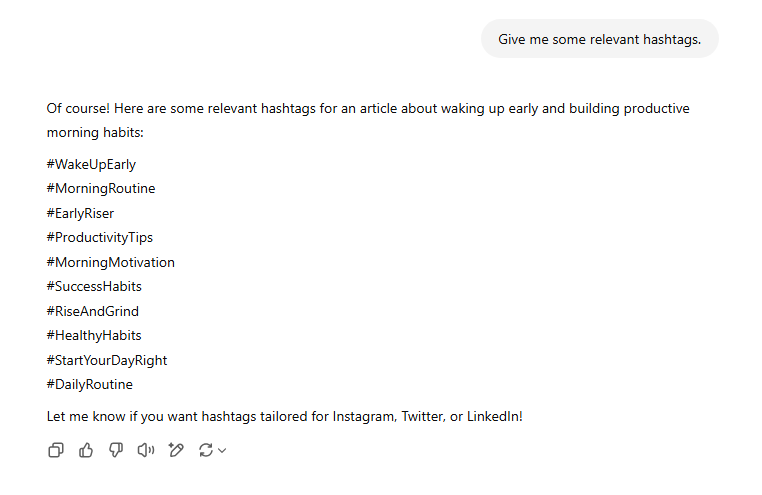
This simple approach can help boost your content’s visibility, reach a wider audience, and attract more followers.
These techniques make ChatGPT’s output more aligned with your marketing goals and audience preferences.
Chrome Extensions for Integrating ChatGPT into Your Workflow
To boost productivity, several Chrome extensions help integrate ChatGPT seamlessly into your browser.
- WebChatGPT: This extension gives ChatGPT access to real-time web data. It lets you adjust the number of sources, timeframe, and even region for more relevant results. You can install WebChatGPT extension.
- ChatGPT Sidebar: Use ChatGPT while browsing. This sidebar displays AI responses alongside search engine results, great for research or quick content creation. You can start installation from this Chrome extension page.
- AIPRM Prompt Library: AIPRM offers a curated set of 1-click prompt templates for SEO, SaaS, and more. You can also customize prompts by tone, language, and writing style. Start using this Chrome extension now.
These tools streamline your workflow, helping you generate, revise, and publish content faster and more efficiently.
Ethical and Legal Considerations When Using AI-Generated Content
As AI-generated content becomes more common, it’s vital to consider its legal and ethical use.
- YMYL Content: You must have the right qualifications if you’re publishing content that affects people’s finances or health. This type of content is often referred to as Your Money or Your Life. Publishing AI-generated health or financial advice without proper skill can lead to legal issues.
- Credibility: If you’re using AI to create content, especially visual media, transparency is critical. Misleading audiences—like passing off AI images as original photography—can damage your reputation.
- Bias: AI models are trained on existing datasets, which can contain biases. Always review AI-generated content for fairness, exclusivity, and accuracy.
- Transparency: Reveal when content is AI-generated. This builds trust with your audience and avoids ethical gray areas.
- Ownership: Clarify content ownership upfront. If AI is used by an agency or team, define whether the developer or business holds the rights.
- Accountability: If your AI-generated content leads to misinformation or harm, you should have protocols in place to correct it. Accountability is crucial in safeguarding brand integrity.
- Privacy: If personal data is used to generate content, obtain proper consent. Ensure that privacy laws are followed.
Final Thoughts on Mastering ChatGPT in Content Marketing
One of the easiest ways to boost productivity is to master ChatGPT in content marketing. Let AI handle the heavy lifting. ChatGPT is revolutionizing content marketing, but it’s not just about automation—it’s about amplification.
Whether you’re a seasoned marketer or a small business owner, you can use AI to support your content strategy. This approach can drastically improve efficiency. It can also boost results.
Discover more from DigiSatish
Subscribe to get the latest posts sent to your email.